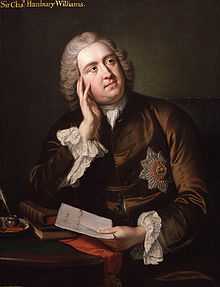Charles Hanbury Williams

Sir Charles Hanbury Williams, KB (8 December 1708 – 2 November 1759) was a Welsh diplomat, writer and satirist.
Life
The son of John Hanbury, a Welsh ironmaster, assumed the name of Williams under the terms of a bequest from his godfather Charles Williams, in 1720.
On 1 July 1732 at Saint James, Westminster, London, he married Lady Frances Coningsby (15 January 1707/1708 – buried at Westminster Abbey, Westminster, London, 31 December 1781), daughter of Thomas Coningsby, 1st Earl Coningsby and Lady Frances Jones. They had two daughters: Frances married William Capel, 4th Earl of Essex and Charlotte Robert Boyle Walsingham, youngest son of the Earl of Shannon.
He entered the British Parliament in 1734 representing the Monmouthshire constituency as a supporter of Robert Walpole, and held the seat until 1747. Sir Charles then won the seat of Leominster in 1754 which he held until his death.
In 1739 he supported the establishment of the Foundling Hospital and served as one of its founding governors.
From 1747 till 1750, he was the British ambassador in Dresden. In 1748 he was in Poland and witnessed a Polish Sejm, where he met members of the influential Czartoryski family (August Aleksander Czartoryski). When the future King of Poland, Stanisław Poniatowski, was receiving medical treatment in Berlin, he met with Sir Charles, who was sent there as ambassador (1750–1751). The Englishman became part of Polish and Russian history by introducing Stanisław to the Russian Grand Duchess Catherine Alexeyevna (Saint Petersburg 1755) (the future Catherine the Great, Empress of Russia). From this moment on began the famous romance between Catherine and the Polish aristocrat.
.jpg)
His father bought the Coldbrook Park estate near Abergavenny for him from his godfather's bequest where in 1746 he reconstructed the house by adding a 9 bay 2-storey Georgian facade.
He died insane in 1759 and the Coldbrook estate passed to his brother George.[1]
Seven Years' War
He played a major role as a British envoy during the Seven Years' War at the court in Russia. While Russia was at war with Britain's ally Prussia, the two countries remained at peace.
Sir Charles is recorded as a brilliant wit with a great reputation for lively and biting satire.
Legacy
He was the inspiration for the character Charles Edaston in the 1913 George Bernard Shaw play Great Catherine, which recounts the story of a British envoy to Catherine's court. It was made into a film starring Peter O'Toole in 1968. Williams also left poems which were said to be "witty but licentious".[2]
Sources
- ↑ An Historical Tour in Monmouthshire, Volume 2. p. 279.
- ↑ Davenport, Richard Alfred (1831). A Dictionary of Biography p.571. Chiswick Press.
![]() This article incorporates text from a publication now in the public domain: Cousin, John William (1910). A Short Biographical Dictionary of English Literature. London: J. M. Dent & Sons. Wikisource
This article incorporates text from a publication now in the public domain: Cousin, John William (1910). A Short Biographical Dictionary of English Literature. London: J. M. Dent & Sons. Wikisource
Further reading
- Horn, David B., Sir Charles Hanbury Williams and European diplomacy, 1747–58, London et al. 1930: Harrap.
| Parliament of Great Britain | ||
|---|---|---|
| Preceded by John Hanbury Thomas Morgan |
Member of Parliament for Monmouthshire 1735–1747 With: Thomas Morgan |
Succeeded by William Morgan Capel Hanbury |
| Preceded by Robert de Cornwall James Peachey |
Member of Parliament for Leominster 1754–1759 With: Richard Gorges |
Succeeded by Richard Gorges Chase Price |
| Diplomatic posts | ||
| Preceded by Hon. Thomas Villiers |
British Ambassador to Poland 1747–1755 |
Succeeded by Viscount Stormont |
| British Ambassador to Saxony 1747–1750 | ||
| Preceded by Henry Legge |
British Ambassador to Prussia 1749–1751 |
Unknown Next known title holder: Andrew Mitchell |
| Preceded by The Earl of Hyndford |
British Ambassador to Russia 1752–1759 |
Succeeded by Robert Murray Keith the Elder |
| Honorary titles | ||
| Preceded by The Duke of Chandos |
Lord Lieutenant of Herefordshire 1741–1747 |
Succeeded by The Viscount Bateman |
|